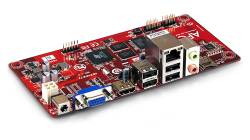# WM8750
# Apricot R4 on NAND, for APC.io WM8750
## Overview
 For memory. Adapted from this repost, original source: RoyalPanda from APC.IO forum.
For memory. Adapted from this repost, original source: RoyalPanda from APC.IO forum.
The plot is simple: How to install a _real_ GNU/Linux on the APC.io wm8750 PicoITX board. Royal Panda made a great job adapting Raspbian for the APC, he called this remix Apricot
The last release is Apricot R5, but it still lacks Video support (among others things) and Royal Panda didn't release any NAND installer. So this _“tutorial”_ is made with the previous release: Apricot R4. The process should stay the same if there's an update one day…
Long story short: I needed to reinstall my APC board, but the kernel I had (and though was the one from the installer) lacks the UBI support, so I couldn't follow the original Howto…
## Steps ### What you'll need
* The board itself, the original APC.io board: WM8750 * A 1 Gio MicroSD card * An Ethernet connection * A Serial adapter * Screen and Keyboard might help too…
### Files
* The Installer Files with a scriptcmd file (it's easier this way, but don't worry, you'll play with uBoot via Serial) * mtd-utils deb package (so you don't have to type the URL to download it) * mod-kernel-RaspBian.tar.gz (the Kernel to be flashed on the NAND)
I've made a bundle with the useful files: Here
* Apricot R4 MMC (for its rootfs): Here
### MicroSD preparation
The easy way is to copy the Apricot R4 img on the uSD card, then add the the other files on the first partition.
dd if=./ApricotR4-NoGUI-1G-SDCARD.img of=/dev/sdh bs=4096
There should be one partition named XCP-1.6.10 Base Pack. Copy the files initrd.gz, uzImage.bin, scriptcmd, mtd-utils (DEB package) there, replace the existing files (uzImage.bin and scriptcmd)
Create a folder where you extract the mod-kernel-RaspBian.tar.gz archive. Mine's named modKern.
### First boot Insert the MicroSD card, boot the board. The debian-installer should start (on the screen, not in serial). Choose your language, you don't need the Network. Stop the installer as soon as you can, and drop to a Shell. From the menu, it's the Execute a shell option.
Make sure your NAND layout is correct:
cat /proc/mtd
You should see this:
dev: size erasesize name mtd0: 00d00000 00010000 "filesystem-SF" mtd1: 00280000 00010000 "kernel-SF" mtd2: 00050000 00010000 "u-boot-SF" mtd3: 00010000 00010000 "u-boot env. cfg. 1-SF" mtd4: 00010000 00010000 "u-boot env. cfg. 2-SF" mtd5: 00010000 00010000 "w-load-SF" mtd6: 00a00000 00100000 "kernel" mtd7: 7f600000 00100000 "rootfs"
<note warning>If your layout is different, stop here unless you know what you're doing…</note>
Mount the first partition of the uSD card somewhere, Flash the kernel on the NAND (mtd6)
mkdir /mnt mount /dev/mmcblk0p1 /mnt cd /mnt/modKern dd if=uzImage.bin of=/dev/mtdblock6
<note tip>You can try to erase the mtd partition before flashing the kernel, but I'm not sure it'd work, and if that's really necessary since dd does a raw copy…</note>
Shutdown the board. Unplug the uSD card.
### Second Boot Connect your serial adapter, open with these parameters: 115200 8n1 without any flow control.
Restart the board.Interrupt the boot process in uBoot by pressing Enter. It should drop you to a uBoot shell. Enter theses lines
setenv nandargs "setenv bootargs mem=460M ubi.mtd=7 root=/dev/mmcblk0p2 console=ttyS0,115200n8 console=tty0 mtdparts=WMT.nand:10m(kernel),-(rootfs)" setenv nandboot "nandrw r 0x0 0x1000000 0x400000; if iminfo 0x1000000; then run nandargs; bootm 0x1000000; fi"
then
boot
When the Kernel starts booting, insert the uSD card so it can find the rootfs. When the system is ready, you should be able to connect using SSH. Login: root, password: apricot. Use the physical screen and keyboard to find out the IP address
From now it's pretty much the same as the original HowTo. Format the mtd7 partition (the rootfs)
mount /dev/mmcblk0p1 /mnt dpkg -i /mnt/mtd-utils_1.5.0-1_armhf.deb umount /mnt ubidetach -d 0 ubiformat /dev/mtd7 ubiattach -p /dev/mtd7 ubimkvol /dev/ubi0 -m -N rootfs mount -t ubifs ubi0:rootfs /mnt
Debootstrap Time ! It ccan be quite long, so… once you've seen it's start correctly, go do something else, have a coffe, take a (short) nap, …
apt-get install -y debootstrap debootstrap --no-check-gpg wheezy /chroot http://mirrordirector.raspbian.org/raspbian/
Once it's done, you can chroot in your new system !
mount -t proc none /mnt/proc mount -t sysfs none /mnt/sys mount -o bind /dev /mnt/dev chroot /mnt
You should now be using the rootfs on NAND, time to setup the Raspbian distro
mount /dev/mmcblk0p1 /mnt cp -R /mnt/modKern/modules /lib/ depmod
Install uBoot tools to be able to change the uBoot parameters if/when you need
apt-get install u-boot-tools echo "/dev/mtd3 0x0000 0x10000 0x10000" > /etc/fw_env.config echo "/dev/mtd4 0x0000 0x10000 0x10000" >> /etc/fw_env.config fw_printenv ## Should print the uBoot env
Make the previous setenv changes permanent:
fw_setenv nandargs "setenv bootargs mem=460M ubi.mtd=7 root=ubi0:rootfs rootfstype=ubifs console=ttyS0,115200n8 console=tty0 mtdparts=WMT.nand:10m(kernel),-(rootfs)" fw_setenv nandboot "nandrw r 0x0 0x1000000 0x400000; if iminfo 0x1000000; then run nandargs; bootm 0x1000000; fi"
Setup you debian installation
passwd echo "proc /proc proc defaults 0 0" >> /etc/fstab echo "ubi0:rootfs / ubifs defaults 0 0" >> /etc/fstab echo "" >> /etc/network/interfaces echo "allow-hotplug eth0" >> /etc/network/interfaces echo "iface eth0 inet dhcp" >> /etc/network/interfaces
Install the SSH server
apt-get update apt-get install openssh-server tmux
Edit the inittab to enable a serial session, just in case…
nano /etc/inittab
That should be it, you can safely poweroff the board, unplug the uSD card, then reboot.
### That's all folks !
Well, you now have a working Debian Wheezy system. I haven't tested all the graphic part, since it's running as server under my desk, but it should work fine…
## Troubleshooting
The board doesn't start ? Even with Firmware 1.2, it seems the board sometimes needs a screen attached to complete the boot process and connect to the network…